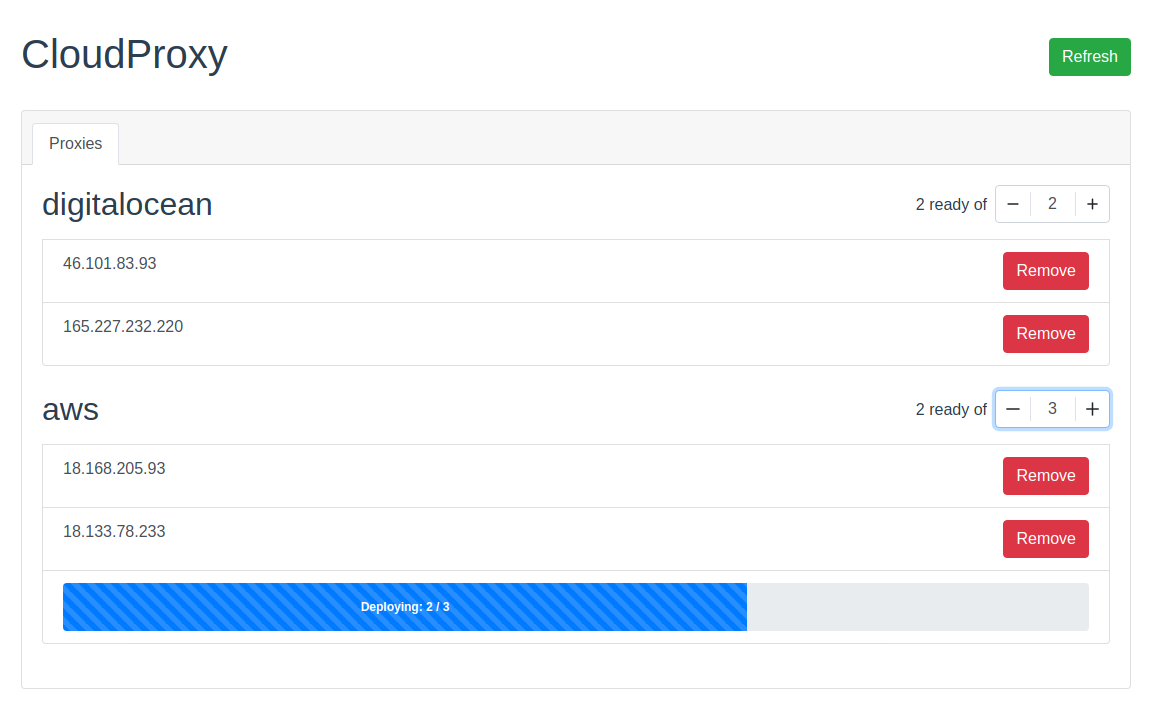The purpose of CloudProxy is to hide your scrapers IP behind the cloud. It allows you to spin up a pool of proxies using popular cloud providers with just an API token. No configuration needed.
CloudProxy exposes an API with the IPs and credentials of the provisioned proxies.
- Google Cloud
- Azure
- Scaleway
- Vultr
This project was inspired by Scrapoxy, though that project no longer seems actively maintained.
The primary advantage of CloudProxy over Scrapoxy is that CloudProxy only requires an API token from a cloud provider. CloudProxy automatically deploys and configures the proxy on the cloud instances without the user needing to preconfigure or copy an image.
To get a local copy up and running follow these simple steps.
All you need is:
- Docker
USERNAME - set the username for the forward proxy.
PASSWORD - set the password for the forward proxy.
AGE_LIMIT - set the age limit for your forward proxies in seconds. Once the age limit is reached, the proxy is replaced. A value of 0 disables the feature. Default value: 0.
See individual provider pages for environment variables required in above providers supported section.
For example:
docker run -e USERNAME='CHANGE_THIS_USERNAME' \
-e PASSWORD='CHANGE_THIS_PASSWORD' \
-e DIGITALOCEAN_ENABLED=True \
-e DIGITALOCEAN_ACCESS_TOKEN='YOUR SECRET ACCESS KEY' \
-it -p 8000:8000 laffin/cloudproxy:latestIt is recommended to use a Docker image tagged to a version e.g. laffin/cloudproxy:0.3.0-beta, see releases for latest version.
CloudProxy exposes an API on localhost:8000. Your application can use the below API to retrieve the IPs with auth for the proxy servers deployed. Then your application can use those IPs to proxy.
The logic to cycle through IPs for proxying will need to be in your application, for example:
import random
import requests as requests
# Returns a random proxy from CloudProxy
def random_proxy():
ips = requests.get("http://localhost:8000").json()
return random.choice(ips['ips'])
proxies = {"http": random_proxy(), "https": random_proxy()}
my_request = requests.get("https://api.ipify.org", proxies=proxies)You can manage CloudProxy via an API and UI. You can access the UI at http://localhost/ui.
You can scale up and down your proxies and remove them for each provider via the UI.
GET /
curl -X 'GET' 'http://localhost:8000/' -H 'accept: application/json'
{"ips":["http://username:password:192.168.0.1:8899", "http://username:password:192.168.0.2:8899"]}
GET /random
curl -X 'GET' 'http://localhost:8000/random' -H 'accept: application/json'
["http://username:password:192.168.0.1:8899"]
DELETE /destroy
curl -X 'DELETE' 'http://localhost:8000/destroy?ip_address=192.1.1.1' -H 'accept: application/json'
["Proxy to be destroyed"]
GET /provider/digitalocean
curl -X 'GET' 'http://localhost:8000/providers/digitalocean' -H 'accept: application/json'
{
"ips": [
"192.1.1.2",
"192.1.1.3"
],
"scaling": {
"min_scaling": 2,
"max_scaling": 2
}
}
PATCH /provider/digitalocean
curl -X 'PATCH' 'http://localhost:8000/providers/digitalocean?min_scaling=5&max_scaling=5' -H 'accept: application/json'
{
"ips": [
"192.1.1.2",
"192.1.1.3"
],
"scaling": {
"min_scaling": 5,
"max_scaling": 5
}
}
CloudProxy runs on a schedule of every 30 seconds, it will check if the minimum scaling has been met, if not then it will deploy the required number of proxies. The new proxy info will appear in IPs once they are deployed and ready to be used.
The project is at early alpha with limited features. In the future more providers will be supported, autoscaling will be implemented and a rich API to allow for blacklisting and recycling of proxies.
See the open issues for a list of proposed features (and known issues).
Contributions are what make the open source community such an amazing place to be learn, inspire, and create. Any contributions you make are greatly appreciated.
- Fork the Project
- Create your Feature Branch (
git checkout -b feature/AmazingFeature) - Commit your Changes (
git commit -m 'Add some AmazingFeature') - Push to the Branch (
git push origin feature/AmazingFeature) - Open a Pull Request
Distributed under the MIT License. See LICENSE for more information.
Your Name - @christianlaffin - christian.laffin@gmail.com
Project Link: https://github.com/claffin/cloudproxy









